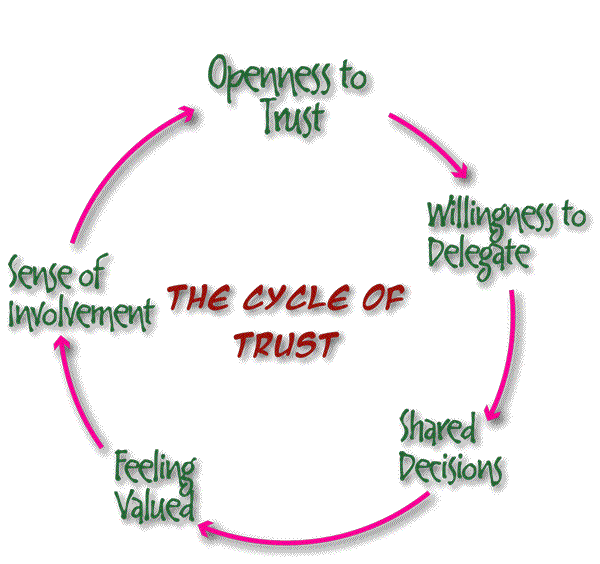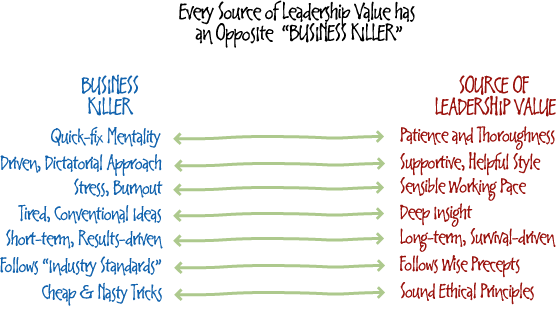Building Trust
What does it take to initiate a process of trust? Courage, certainly, and the willingness to take a risk. Employees who have been denied trust, maybe for years, don’t find it easy to accept responsibility in an instant. You’ll need to help them rebuild their confidence in themselves. You’ll probably have to deal with more than few cynics as well: people who claim to approve the idea of trust, yet constantly find reasons why it shouldn’t be this person, in this circumstance, at this time.
Risks versus Rewards
There are always risks involved in offering trust. Some people—very few, in my experience—will consciously abuse your trust. If so, you may also need the courage and wisdom to refuse to allow the actions of a tiny minority to shape the way you deal with everyone. Others may stumble and betray your trust without intending to. You need to be willing to show them mercy and provide help, not instant condemnation. It’s easy to focus primarily on the negative possibilities: the people who will not live up to the trust placed in them. In reality, the potential for positive outcomes is high enough to tilt the balance of advantage that way.
The results of trust abused are obvious. You find yourself blamed for being “naive” and “too soft.” You suffer a loss of credibility and political standing. You may have to deal with a problem you didn’t expect, or try to reverse losses that might have been avoided by putting less trust in others.
But what are the risks on the other side: The risks of creating a culture marked by chronic lack of trust? Those risks include:
- A culture of obsessive secrecy, so important information is not shared and unnecessary mistakes are common.
- An organization where all significant decisions, particularly financial ones, must be referred upwards, clogging senior management time and slowing progress to a snail's pace.
- A “silo” organization, with little or no sharing of information between departments, so the wheel is regularly re-invented.
- Internal competitiveness that swamps efforts at co-operation and takes attention away from competing in the marketplace.
- Growing numbers of “in groups” and cliques that wreck communication and distract the organization through excessive political partisanship.
- Resulting strong class consciousness between “insiders” and the rest.
- A culture of protecting your butt first and getting results or serving the customer last.
- Staff who are paid to do jobs they don’t do fully, because their bosses don’t trust them, so do the work themselves instead.
Saving Time
Building trust takes time, but far less than is wasted by needing to check every significant piece of work and do more work yourself than makes any sense. Part of the deluge of work swamping leaders is due to lack of trust in their subordinates. Delegation no longer seems an option.
The more time leaders spend with their people, the more likely they’ll feel they can trust them. It’s human nature to be somewhat suspicious of those we don’t know very well. You can’t guarantee that giving your staff more time will always increase mutual feelings of trust, but it’s bound to help. A little time invested in this way can save a lot of time later, when staff truly do what they are supposed to do, and take much of the burden of routine work away from those in more senior positions.
There’s a bonus to creating trust. When your staff trust you, they will look out for you. Many a leader has been saved from bad mistakes—and not a few political ambushes by rivals—because of timely warnings by alert subordinates.
Whom Do You Value?
Trusting someone is essential to valuing them. Imagine saying to someone, “I truly value your contribution to our team . . . but I don’t actually trust you.” There’s no value without trust. That goes for customers as much as employees. All those fine words and positive feelings about valuing the customer are destroyed in an instant by a single instance where the customer realizes he or she isn’t trusted. Exactly the same happens with employees. The message is quickly spread that nobody is really valued by the organization, save those in the charmed circle at the top.
Command-and-control executives display little or no trust towards anyone other then themselves and their chosen cronies. This exacerbates the “us” versus “them” attitudes that mistrust produces. Add to this the “audit mentality” that prevails in many businesses, and you have an attitude that those not found to be untrustworthy have simply been too clever to get caught (yet). The “audit mentality” usually defines most financial decision as significant and require them to be referred to one of a handful of officers given the authority to spend money. If you can’t trust managers to spend a few hundred dollars wisely, what can you trust them to do?
Slow Down!
Speed and haste undermine trust. Many leaders don’t intend to suggest a lack of trust in their people, but that is how their actions are interpreted. There isn’t time to explain or coach, so they do the job themselves instead. With maybe only a few moments to make a decision, it seems obvious the leader should do it—there isn’t time to risk making a mistake. That’s isn’t how it will look to the staff, whether it’s true or not. Staff will believe the leader does the work herself because she doesn’t trust them to do it properly.“She’s a control freak,” they’ll tell one another. “She makes every decision of any importance. Oh, she says it’s because of time pressures, but the real reason is she thinks we’re all dummies. She doesn’t even trust us to make the decisions that are crucial to our work.”
Don’t risk it. Even the “losses” caused by a few genuinely untrustworthy people, and the inevitable frailties of human nature, are minor compared with the damage leaders do when they choose to withhold their trust from the people who work for them. Too many organizations today are wasting money and resources by failing to use the full creative abilities and commitment of their people. Chronic mistrust soon shows on the bottom line.
It’s not just true that if you pay peanuts you get monkeys. If you treat people as untrustworthy through assumed incompetence, low motivation or downright dishonesty, that’s exactly what you’ll get. When you treat employees as feckless dummies, all the good ones will leave, while the rest behave exactly as you seem to expect. A leader without the courage to trust people is as much use as any coward in a fire fight.









